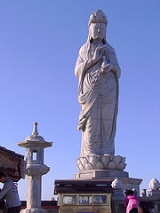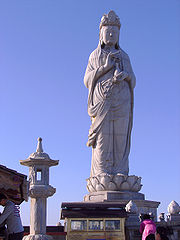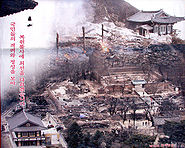
Naksansa
Encyclopedia
Naksansa or Naksan Temple is a Korean Buddhist temple complex in the Jogye order of Korean Buddhism
that stands on the slopes of Naksan Mountain (also called "Obongsan Mountain"). It is located about midway between Sokcho
and Yangyang, Gawngwon Province
, eastern region of South Korea
. Naksansa is one of the few temples in Korea
to overlook the East Sea.
Naksan is an abbreviated term of Botarakgasan in Korean
to refers to "Potalaka Mountain", the place where the Avalokitesvara
Bodhisattva
is believed to live. Thus, Naksan Mountain is also known as Korea's Potalaka Mountain. The Bodhisattva is said to live on a sea-bound island along with guardian dragons. Naksansa is regarded as one of the great eight scenic areas in the Eastern region of Korea, known as "Gwandong Palgyeong" (관동팔경).
, Uisang
Daesa (Grand Master Uisang), an ambassador of the 30th King Munmu
of the Silla
Period (BC 57-AD 935) after he had returned from studying abroad during the Chinese Tang Dynasty
, who, while meditating
near the cave in which the Avalokitesvara Bodhisattva (Gwaneumbosal) was believed to have lived, was told by the Bodhisattva to build the temple there.
Today, the octagonal Uisangdae Pavilion
sits on the spot where Uisang once meditated, the current pavilion having been built in 1925.
 Mount Naksan is crowned by the Buddhist statue of Haesugwaneumsang (해수관음입상, Bodhisattva of Mercy), known as the goddess Gwanseum-Bosal, facing southeast standing 15 meters (49 ft) high on a 2.8-meter (9 ft) high pedestal. The white granite statue stands in a clearing at the top of the hill, eyes and fingers closed in peaceful meditation as it gazes out to sea. The massive statue is the work of Busan
Mount Naksan is crowned by the Buddhist statue of Haesugwaneumsang (해수관음입상, Bodhisattva of Mercy), known as the goddess Gwanseum-Bosal, facing southeast standing 15 meters (49 ft) high on a 2.8-meter (9 ft) high pedestal. The white granite statue stands in a clearing at the top of the hill, eyes and fingers closed in peaceful meditation as it gazes out to sea. The massive statue is the work of Busan
sculptor Gwon Jeong-hwan (권정환) and was dedicated in 1977. 700 tons of granite and six months were required to complete the sculpture. It is the largest Buddhist statue of its kind in the Orient
.
Hongreanam was built by Uisang
as a Hermitage
above a stone cave. In the sanctuary floor there is a 10-centimeter (4 in) opening through which you can see the sea below.
Naksansa's seven storied stone pagoda
, Naksansa Chilcheung Seoktap (Seven storied stone pagoda in Naksansa Temple) built in 1467, the 13th year of the reign of King Sejo
, is Treasure No.499. During a repair, it is said that a Buddhist rosary and a magic bead were sealed inside the pagoda. The seven storied stone pagoda is an example of the Goryeo
style pagoda having a single square foundation. The square foundation on this pagoda is carved with 24 lotus petals. Of special note is a stone prop in each story, which is larger and thicker than its body stone. The pagoda is formed with thin eaves, a straight slope, and upward edges. On the finial
, around the long thin, bronze rod are ornaments similar to those in Lama
pagoda of Yuan Dynasty
(1279-1368) in China
. Mostly it follows the rather simple style of the Goryeo pagodas though.
 Most of Naksansa was destroyed by a fire that started in the surrounding forest on April 5, 2005. The temple bell, a national treasure dated 15th century, was also melted and destroyed in the fire. The museum displays a violin and cello built from wood found on the temple grounds that survived the fire.
Most of Naksansa was destroyed by a fire that started in the surrounding forest on April 5, 2005. The temple bell, a national treasure dated 15th century, was also melted and destroyed in the fire. The museum displays a violin and cello built from wood found on the temple grounds that survived the fire.
The temple was earlier destroyed by fire during the Mongolian invasion of the 13th century. During the Joseon Dynasty
(1392-1910) the temple was repeatedly reconstructed and expanded by royal order in 1467, 1469, 1631 and 1643. The pre-2005 fire facilities were constructed in 1953 after the buildings were again destroyed during the 1950-53 Korean War
.
Present reconstruction is well under way as can be seen in the gallery bellow. The new construction projects are expected to be completed and the temple fully restored by 2010.
Jogye Order
The Jogye Order, officially the Jogye Order of Korean Buddhism is the representative order of traditional Korean Buddhism with roots that date back 1,200 years to Unified Silla National Master Doui, who brought Seon and the practice taught by the Sixth Patriarch, Huineng, from China about 820...
that stands on the slopes of Naksan Mountain (also called "Obongsan Mountain"). It is located about midway between Sokcho
Sokcho
Sokcho is a city in Gangwon-do province, South Korea. It is located in the far northeast of Gangwon-do. Lying north of the 38th parallel, the city belonged to North Korea from 1945 until the end of the Korean War, when the dividing line between the two Korean states was officially altered....
and Yangyang, Gawngwon Province
Gangwon-do (South Korea)
Gangwon-do is a province of South Korea, with its capital at Chuncheon. Before the division of Korea in 1945, Gangwon and its North Korean neighbour Kangwŏn formed a single province.-History:...
, eastern region of South Korea
South Korea
The Republic of Korea , , is a sovereign state in East Asia, located on the southern portion of the Korean Peninsula. It is neighbored by the People's Republic of China to the west, Japan to the east, North Korea to the north, and the East China Sea and Republic of China to the south...
. Naksansa is one of the few temples in Korea
Korea
Korea ) is an East Asian geographic region that is currently divided into two separate sovereign states — North Korea and South Korea. Located on the Korean Peninsula, Korea is bordered by the People's Republic of China to the northwest, Russia to the northeast, and is separated from Japan to the...
to overlook the East Sea.
Naksan is an abbreviated term of Botarakgasan in Korean
Korean language
Korean is the official language of the country Korea, in both South and North. It is also one of the two official languages in the Yanbian Korean Autonomous Prefecture in People's Republic of China. There are about 78 million Korean speakers worldwide. In the 15th century, a national writing...
to refers to "Potalaka Mountain", the place where the Avalokitesvara
Avalokitesvara
Avalokiteśvara is a bodhisattva who embodies the compassion of all Buddhas. He is one of the more widely revered bodhisattvas in mainstream Mahayana Buddhism....
Bodhisattva
Bodhisattva
In Buddhism, a bodhisattva is either an enlightened existence or an enlightenment-being or, given the variant Sanskrit spelling satva rather than sattva, "heroic-minded one for enlightenment ." The Pali term has sometimes been translated as "wisdom-being," although in modern publications, and...
is believed to live. Thus, Naksan Mountain is also known as Korea's Potalaka Mountain. The Bodhisattva is said to live on a sea-bound island along with guardian dragons. Naksansa is regarded as one of the great eight scenic areas in the Eastern region of Korea, known as "Gwandong Palgyeong" (관동팔경).
History
Naksansa was founded in 671, by the Buddhist monkBhikkhu
A Bhikkhu or Bhikṣu is an ordained male Buddhist monastic. A female monastic is called a Bhikkhuni Nepali: ). The life of Bhikkhus and Bhikkhunis is governed by a set of rules called the patimokkha within the vinaya's framework of monastic discipline...
, Uisang
Uisang
Uisang was one of the most eminent early Silla Korean scholar-monks, a close friend of Wonhyo .He traveled to China, studying at Mount Zhongnan as a student of the influential Huayan master Zhiyan and as a senior colleague of Fazang , with whom he established a lifelong correspondence...
Daesa (Grand Master Uisang), an ambassador of the 30th King Munmu
Munmu of Silla
Munmu of Silla was the thirtieth king of the Korean kingdom of Silla. He is usually considered to have been the first ruler of the Unified Silla period. Munmu was the son of King Muyeol and Munmyeong, who was the younger sister of Kim Yu-shin...
of the Silla
Silla
Silla was one of the Three Kingdoms of Korea, and one of the longest sustained dynasties in...
Period (BC 57-AD 935) after he had returned from studying abroad during the Chinese Tang Dynasty
Tang Dynasty
The Tang Dynasty was an imperial dynasty of China preceded by the Sui Dynasty and followed by the Five Dynasties and Ten Kingdoms Period. It was founded by the Li family, who seized power during the decline and collapse of the Sui Empire...
, who, while meditating
Meditation
Meditation is any form of a family of practices in which practitioners train their minds or self-induce a mode of consciousness to realize some benefit....
near the cave in which the Avalokitesvara Bodhisattva (Gwaneumbosal) was believed to have lived, was told by the Bodhisattva to build the temple there.
Today, the octagonal Uisangdae Pavilion
Chinese pavilion
.Chinese Pavilions are covered structures without surrounding walls and are a traditional part of Chinese architecture. While often found within temples, pavilions are not exclusively religious structures...
sits on the spot where Uisang once meditated, the current pavilion having been built in 1925.
Treasures

Busan
Busan , formerly spelled Pusan is South Korea's second largest metropolis after Seoul, with a population of around 3.6 million. The Metropolitan area population is 4,399,515 as of 2010. It is the largest port city in South Korea and the fifth largest port in the world...
sculptor Gwon Jeong-hwan (권정환) and was dedicated in 1977. 700 tons of granite and six months were required to complete the sculpture. It is the largest Buddhist statue of its kind in the Orient
Orient
The Orient means "the East." It is a traditional designation for anything that belongs to the Eastern world or the Far East, in relation to Europe. In English it is a metonym that means various parts of Asia.- Derivation :...
.
Hongreanam was built by Uisang
Uisang
Uisang was one of the most eminent early Silla Korean scholar-monks, a close friend of Wonhyo .He traveled to China, studying at Mount Zhongnan as a student of the influential Huayan master Zhiyan and as a senior colleague of Fazang , with whom he established a lifelong correspondence...
as a Hermitage
Hermitage (religious retreat)
Although today's meaning is usually a place where a hermit lives in seclusion from the world, hermitage was more commonly used to mean a settlement where a person or a group of people lived religiously, in seclusion.-Western Christian Tradition:...
above a stone cave. In the sanctuary floor there is a 10-centimeter (4 in) opening through which you can see the sea below.
Naksansa's seven storied stone pagoda
Pagoda
A pagoda is the general term in the English language for a tiered tower with multiple eaves common in Nepal, India, China, Japan, Korea, Vietnam and other parts of Asia. Some pagodas are used as Taoist houses of worship. Most pagodas were built to have a religious function, most commonly Buddhist,...
, Naksansa Chilcheung Seoktap (Seven storied stone pagoda in Naksansa Temple) built in 1467, the 13th year of the reign of King Sejo
Sejo of Joseon
Sejo of Joseon was the seventh king of the Joseon Dynasty of Korea. He produced a coup d'etat and became king himself in 1455.-Reign:...
, is Treasure No.499. During a repair, it is said that a Buddhist rosary and a magic bead were sealed inside the pagoda. The seven storied stone pagoda is an example of the Goryeo
Goryeo
The Goryeo Dynasty or Koryŏ was a Korean dynasty established in 918 by Emperor Taejo. Korea gets its name from this kingdom which came to be pronounced Korea. It united the Later Three Kingdoms in 936 and ruled most of the Korean peninsula until it was removed by the Joseon dynasty in 1392...
style pagoda having a single square foundation. The square foundation on this pagoda is carved with 24 lotus petals. Of special note is a stone prop in each story, which is larger and thicker than its body stone. The pagoda is formed with thin eaves, a straight slope, and upward edges. On the finial
Finial
The finial is an architectural device, typically carved in stone and employed decoratively to emphasize the apex of a gable or any of various distinctive ornaments at the top, end, or corner of a building or structure. Smaller finials can be used as a decorative ornament on the ends of curtain rods...
, around the long thin, bronze rod are ornaments similar to those in Lama
Lama
Lama is a title for a Tibetan teacher of the Dharma. The name is similar to the Sanskrit term guru .Historically, the term was used for venerated spiritual masters or heads of monasteries...
pagoda of Yuan Dynasty
Yuan Dynasty
The Yuan Dynasty , or Great Yuan Empire was a ruling dynasty founded by the Mongol leader Kublai Khan, who ruled most of present-day China, all of modern Mongolia and its surrounding areas, lasting officially from 1271 to 1368. It is considered both as a division of the Mongol Empire and as an...
(1279-1368) in China
China
Chinese civilization may refer to:* China for more general discussion of the country.* Chinese culture* Greater China, the transnational community of ethnic Chinese.* History of China* Sinosphere, the area historically affected by Chinese culture...
. Mostly it follows the rather simple style of the Goryeo pagodas though.
2005 fire and reconstruction

The temple was earlier destroyed by fire during the Mongolian invasion of the 13th century. During the Joseon Dynasty
Joseon Dynasty
Joseon , was a Korean state founded by Taejo Yi Seong-gye that lasted for approximately five centuries. It was founded in the aftermath of the overthrow of the Goryeo at what is today the city of Kaesong. Early on, Korea was retitled and the capital was relocated to modern-day Seoul...
(1392-1910) the temple was repeatedly reconstructed and expanded by royal order in 1467, 1469, 1631 and 1643. The pre-2005 fire facilities were constructed in 1953 after the buildings were again destroyed during the 1950-53 Korean War
Korean War
The Korean War was a conventional war between South Korea, supported by the United Nations, and North Korea, supported by the People's Republic of China , with military material aid from the Soviet Union...
.
Present reconstruction is well under way as can be seen in the gallery bellow. The new construction projects are expected to be completed and the temple fully restored by 2010.
External links and references
- Official site, in Korean
- Naksansa-The Temple of Compassion
- Naksansa burns - a flash presentation
- Cultural Properties Administration
- LeBass, Tom. "Insight Guides - South Korea"

